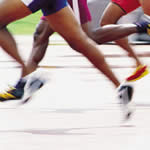Three Keys to Unlocking Your Running Potential
Posted by Matt Russ for Triathlon Life Magazine on 11th Aug 2016
 When an athlete is first introduced to an endurance sport they usually make
the most rapid progress. Virtually any
training results in headway, and the first season may represent a tremendous
leap in performance from baseline.
However, with each successive season the gains become smaller and harder
to come by. It may require progressively
more advanced and accurate training methods to squeeze even the smallest
amounts of performance improvement out of an athlete. The faster you become, the harder it is to
become faster. Here are a few tips for
breaking through those running plateaus that are not related to fitness, but
rather to structure of training and economy.
When an athlete is first introduced to an endurance sport they usually make
the most rapid progress. Virtually any
training results in headway, and the first season may represent a tremendous
leap in performance from baseline.
However, with each successive season the gains become smaller and harder
to come by. It may require progressively
more advanced and accurate training methods to squeeze even the smallest
amounts of performance improvement out of an athlete. The faster you become, the harder it is to
become faster. Here are a few tips for
breaking through those running plateaus that are not related to fitness, but
rather to structure of training and economy.
Use Video to Address Economy
Running faster can be very elusive. I have interviewed runners that have trained (hard) for years, yet made little or no forward progress with their speed. Like swimming, running is a highly technical sport. A runner may reach a tipping point at which an increase in fitness does not necessarily result in an increase in speed if the athlete does not first address economy. In fact, a more fit athlete running with bad form will place greater impact stress on the body and further reinforce the bad economy. Braking forces slow the athlete with each stride, excessive upper body rotation misdirects energy, and any vertical motion other than that which is required to overcome the forces of gravity can add meters of ascension to each mile. However, it is very hard to correct what you can not see or do not understand.
There are what I consider to be many “myths, misconceptions, and metaphors” regarding running form that can be confusing to the athlete, but the bottom line is that it is very hard to correct your form if you do not know what you are doing wrong. Getting some trained, professional eyes on you is a good place to start, and slow motion video playback is the best form of visual feedback. We now have easy and inexpensive access to this technology and it is relatively simple to incorporate. After an economy analysis I send video clips with the athlete to review and compare and encourage them to take their own footage between sessions to assess progress. Once they understand what good form looks like it is much easier to make the mind/body connection along with the drills I prescribe.
Keep Firing
Ultra distance racing requires large volumes of aerobic level training. There may be little room for more peripheral training in an already stretched training time budget. However, athletes tend to fall back into bad habit with long slow distance training, especially when they are chronically fatigued. Running fast causes certain natural adaptations towards better economy. For instance, the arms naturally tend to swing front to back, better directing energy, and contact time is limited.
There is a difference between “speed” training and high intensity training. Speed training does not necessarily have to be overly fatiguing or damaging to the body. Run strides, pick ups, turnovers, and drills are great tools to maintain neuromuscular firing and speed without breaking down the body or requiring a separate training session. A small amount of speed training goes a long way towards maintaining economy, and it can be incorporated into regularly scheduled workouts. The best time to incorporate speed/skill training is after a brief warm up. Start off at a relaxed level and increase speed slightly with each 20-30 second effort- never going all out. Remember, the objective is to maintain the mind/body connection and preserve good form, not to set a new 100m record! Once your form “feels’ right, carry it forward into the remainder of your workout. You can set your watch to beep every mile and do a “form check” for your posture, arm motion, foot strike and stride rate.
Watch the Junk Miles
When it comes to weekly mileage, there is a tendency to “check the box.” Volume is a component of three things: training frequency, intensity, and duration. Mileage does not address all aspects of training volume. Although building a mileage base is very important, especially for newer runners, mileage alone does not create a fast runner. Of the three sports in triathlon, running causes the most muscular breakdown due to the eccentric loading and impact, and consequently requires the most recovery balance. Performing a succession of mediocre workouts on tired legs is not the best process. There should be an equal emphasis on the quality of the workout. If you find that the quality is suffering, do not continue to attempt your mileage goals. The mileage may be simply too much for your individual recovery physiology. Often subtracting a small amount of non-essential training can lead to the next breakthrough once sufficient recovery is in place.
Remember -- the most fit athlete does not necessarily make the fastest athlete. A great many things must come together including economy, plan design, and a level of recovery sufficient enough to facilitate quality training. If you find you are at a plateau, it may be time to add a some new processes and a fresh perspective to your training.
Matt Russ is a full time professional coach with over two decades of experience working with athletes up to the professional level. His athletes have achieved numerous regional, national, and international titles under his direction. Matt has achieved the highest level of licensing by both USA Triathlon and USA Cycling, and is a licensed USA Track and Field Coach. His accomplishments include being named "Team USA" Coach by USA Triathlon. Matt is Head Coach and owner of The Sport Factory, a USA Triathlon Certified Performance Center located in Roswell, Georgia. Visit www.sportfactory.com for more information or email him at coachmatt@sportfactory.com


